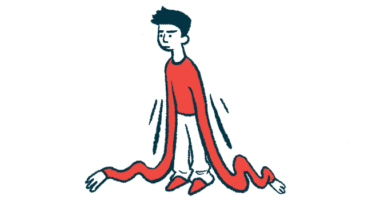Treatment Is Key for All With SMA, But Gains Will Differ

[Editor’s Note: This is part of a series of articles into the discovery and development of Evrysdi — SMA’s newly approved disease-modifying therapy and its first oral and at-home one — as well as the scope of SMA issues and treatments. Here, experts discuss what patients might expect from any SMA treatment based on age, type, and disability.]
Treating newborns whose spinal muscular atrophy (SMA) is discovered in screening programs — before symptoms start — is clearly the best way of ensuring a chance at a “normal life.”
But treatment is hardly an all-or-nothing game, and valuable disease stabilization and some motor gains are possible for those at older ages.
In a series of separate interviews, researcher-clinicians and experts with the SMA Foundation, Genentech (a subsidiary of Roche), and PTC Therapeutics discussed treatment timing in SMA, and what patients over a range of ages might expect in terms of benefits.
SMA is caused by a lack of SMN, a protein essential for motor neuron and muscle health, due to mutations in the SMN1 gene.
A second SMN gene, SMN2, also contains the instructions to produce SMN, but a small difference in its DNA sequence limits the amount of the functional protein it produces to 10% to 15%. The number of SMN2 copies determines disease severity, with higher numbers leading to milder disease forms.
While SMN deficiency may damage a variety of tissues and organs, motor neurons — specialized nerve cells that control voluntary muscle movement — are clearly the most affected cells, dying without SMN and leading to muscle wasting.
Nerve cells typically do not renew, so treatment should be started “without delay and before there’s further loss of these really critical nerve cells,” said Richard Finkel, a pediatric neurologist with St. Jude Children’s Research Hospital in Tennessee.
Increasing evidence establishes earliest possible treatment as the best therapeutic approach for SMA, preventing or slowing further damage.
“As soon as possible means, actually, before symptoms are evident,” said Laurent Servais, PhD, a pediatric neurologist with the MDUK Oxford Neuromuscular Centre. “Whatever the treatment, there is today no patient who has been treated after the symptoms [appear] and who is normal.”
Finkel saw clear support for this in the “remarkable results” of the ongoing Phase 2 NURTURE study (NCT02386553), which opened in 2015 to evaluate Spinraza (the first approved SMA therapy, by Biogen) in 25 presymptomatic infants, those up to 6 weeks old and not yet showing symptoms. All were diagnosed through genetic screening.
After nearly five years of consistent treatment, 96% were able were able to walk with assistance, all were breathing without aid, and many were said to be gaining in motor skills in ways “consistent” with healthy children of a similar age.
These findings made the neurologists strong advocates of including SMA on newborn screening programs worldwide, and for treating patients at birth. But Servais emphasizes that those treated after symptom onset also can realize motor gains, and a better quality of life.
Even “very minor muscle improvement,” changes a healthy person might view as “insignificant,” can be “very, very important” to older patients, Servais said of those he’s treated.
High expectations for infants
All three disease modifying therapies for SMA — Spinraza, Novartis’ gene therapy Zolgensma, and Roche’s recently approved Evrysdi — work to raise levels of the SMN protein.
Repeat clinical trials in all three treatments also show — consistently — that earliest possible treatment is best.
In babies and infants, these therapies restore SMN levels during critical developmental stages, greatly improving their chances of meeting motor milestones like upright head control, sitting, and, for some, standing and walking.
For infants with type 1 SMA, a severe disease form, treatment also prevents the decline of such essential functions as breathing and swallowing. In this disease’s natural history (progression in the absence of treatment), type 1 babies require feeding support by 12 months old, and are either placed on permanent ventilation or die at a median age of 13.5 months.
Given or begun at very young ages — some of Spinraza, Zolgensma and Evrysdi pivotal studies were in babies up to 6 or 7 months old — treatment repeatedly preserved breathing and swallowing abilities, and allowed for gains in motor skills comparable to healthy infants.
Those “remarkable responses” are particularly evident “if you administer it presymptomatically in the first weeks of life,” Finkel said, again supporting the “earlier the better” dogma for SMA treatment.
For older patients, stability amid gains
Older patients, including those diagnosed or treated as toddlers, have “already sustained some loss of motor neurons” and “might not ever be able to gain functions that were lost as a result,” said Karen Chen, a neuroscientist and the SMA Foundation’s CEO
Treatment’s main goal for these children, adolescents, and young adults with milder forms of SMA (types 2 and 3) — which is the majority of today’s SMA population — is to prevent further loss of motor function, or allow for its stability.
“In older SMA patients, stabilization — lack of disease progression — is as important to them as [improvements are] in a very young patient, someone trying to achieve new motor milestones like sitting,” Susan Begelman, MD, vice president of the rare disease and neuroscience medical unit in U.S. medical affairs at Roche’s subsidiary Genentech, said in a February interview.
“For different ages, one’s expectations may need to be different,” she said.
“It’s the little things that count” for older patients, said Stuart Peltz, PhD, PTC’s co-founder and CEO.
“They want to be able to dress themselves, they want to be able to comb their own hair. Even if you can’t change everything, if you can make sure people can maintain those abilities, that’s very powerful for people,” he added.
Both PTC and the SMA Foundation aided Roche and Genentech in developing Evrysdi, whose use led to clinically meaningful improvements — whether gains or stability — in the broadest group of SMA patients, in terms of age and disability level, yet enrolled in a clinical trial.
The two-part, global Phase 2/3 SUNFISH study (NCT02908685) is evaluating the safety and effectiveness of Evrysdi, formerly known as risdiplam, given once a day to people with type 2 or 3 disease, ages 2 to 25.
Not surprisingly, SUNFISH data showed the greatest motor improvements in the youngest age group (2–5 years old), while nearly 60% of those in the oldest group (18–25 years old) achieved motor function stabilization.
Independence in going about daily tasks, like a person eating a meal on their own, brushing their teeth, and writing or using a pen, was also reported to improve with Evrysdi.
“Altogether, patients who are treated later on in the SUNFISH trial are indeed doing better not only in terms of [outcome measures and statistical analyses], but also in their real lives,” Servais said.
Treatment at all ages can lead to meaningful quality of life improvements, he added, “but if we want to take the major advantage of treatment, we need to treat as soon as possible.”







